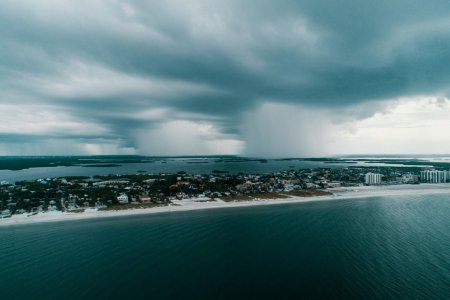Hurricane season is almost here—what experts say you should do now to stay safe
By
Veronica E.
- Replies 0
With hurricane season just around the corner, emergency officials are urging Americans to take early action before the storms begin.
From stocking up on essentials to reviewing evacuation plans, preparation could make all the difference in what experts say may be one of the most active hurricane seasons in recent memory.
While coastal communities are no strangers to storm prep, this year’s outlook is raising the stakes.
Whether you’ve weathered hurricanes before or this is your first season in a high-risk area, having a plan in place now—before the skies darken—can help keep you and your loved ones safe.
The latest outlook from the National Oceanic and Atmospheric Administration (NOAA) warns that the 2025 hurricane season could bring up to 19 named storms, including 10 hurricanes and as many as 5 major hurricanes.
For perspective, last year’s hurricane season saw 18 named storms and resulted in nearly 400 deaths—the deadliest season since 2005.

“We’ve got to convince people of the danger,” said Ken Graham, director of NOAA’s National Weather Service.
One startling fact: every Category 5 hurricane that has ever struck the US began as a tropical storm—or something even weaker—just three days before landfall.
That means storms can strengthen quickly, and those who wait too long to prepare may be caught off guard.
What makes this year different
A few key climate conditions are creating a perfect storm for more severe activity:
Some meteorologists are even warning that the season could start early this year, possibly in May, even though the official start is June 1.
Also read: Hurricane season is heating up—here’s what forecasters want you to know
Why early preparation matters
Last year’s storms caused more than $500 billion in damage.
New forecasting tools from NOAA may provide more precise predictions and earlier alerts, but preparation remains the most effective form of protection.
“The number one thing to do before hurricane season is know your threat,” Graham said.
How to get ready: a hurricane preparedness checklist
Here are key steps to take now, well before the first storm is on the radar:
1. Stock up on essentials
2. Review evacuation plans
Also read: Think you can swim safely? National Hurricane Center to roll out new rip current risk map
3. Secure important documents
Also read: Feds Warn: Beware of Rising Hurricane Scams—Here’s How to Protect Your Wallet!
Additional tips for older adults and those with health needs
If you or someone in your household has mobility challenges or medical needs, consider these added steps:
What’s fueling stronger storms?
Hurricanes draw power from warm ocean waters.
When those waters are unusually hot—as they are now—storms can grow rapidly.
El Niño typically brings wind shear that disrupts hurricanes, but without it, and with La Niña possibly developing later this year, the Atlantic could see more storms, stronger storms, and faster-developing systems.
Experts are clear: don’t wait until a storm is heading your way.
Even a short delay can limit your options and increase your risk.
Take time this week to get your household ready—you’ll be glad you did!
Read next: Protect Your Savings: How a Veteran Lost $40,000 in a Heart-Wrenching Post-Hurricane Scam

Have you lived through a major storm before? What helped you stay safe and comfortable? Do you have questions about what to prepare this season? Share your thoughts and advice in the comments—your story could help others stay safe this year!
From stocking up on essentials to reviewing evacuation plans, preparation could make all the difference in what experts say may be one of the most active hurricane seasons in recent memory.
While coastal communities are no strangers to storm prep, this year’s outlook is raising the stakes.
Whether you’ve weathered hurricanes before or this is your first season in a high-risk area, having a plan in place now—before the skies darken—can help keep you and your loved ones safe.
The latest outlook from the National Oceanic and Atmospheric Administration (NOAA) warns that the 2025 hurricane season could bring up to 19 named storms, including 10 hurricanes and as many as 5 major hurricanes.
For perspective, last year’s hurricane season saw 18 named storms and resulted in nearly 400 deaths—the deadliest season since 2005.

With forecasters warning of a highly active hurricane season, early preparation can help keep families safe. Image Source: Pexels / Josh Sorenson.
“We’ve got to convince people of the danger,” said Ken Graham, director of NOAA’s National Weather Service.
One startling fact: every Category 5 hurricane that has ever struck the US began as a tropical storm—or something even weaker—just three days before landfall.
That means storms can strengthen quickly, and those who wait too long to prepare may be caught off guard.
What makes this year different
A few key climate conditions are creating a perfect storm for more severe activity:
- The absence of El Niño, a weather pattern that usually helps suppress hurricane formation, means there’s no natural check on storm development.
- In fact, there’s a chance that we’ll shift into La Niña, which tends to fuel more hurricanes in the Atlantic.
- Ocean temperatures in the Caribbean and Gulf of Mexico are already well above normal—conditions that can help storms grow faster and stronger.
Some meteorologists are even warning that the season could start early this year, possibly in May, even though the official start is June 1.
Also read: Hurricane season is heating up—here’s what forecasters want you to know
Why early preparation matters
Last year’s storms caused more than $500 billion in damage.
New forecasting tools from NOAA may provide more precise predictions and earlier alerts, but preparation remains the most effective form of protection.
“The number one thing to do before hurricane season is know your threat,” Graham said.
How to get ready: a hurricane preparedness checklist
Here are key steps to take now, well before the first storm is on the radar:
1. Stock up on essentials
- One gallon of water per person per day (for at least 3 days)
- Non-perishable food and snacks
- A two-week supply of prescription and over-the-counter medications
- Flashlights, batteries, and a battery-powered radio
- First aid supplies
- Cash in small bills (in case power outages affect ATMs)
- Full gas tanks and spare fuel for generators
2. Review evacuation plans
- Know your community’s evacuation routes and shelters
- Make transportation plans in advance
- Identify pet-friendly shelter options if needed
Also read: Think you can swim safely? National Hurricane Center to roll out new rip current risk map
3. Secure important documents
- Keep insurance records, IDs, and medical information in a waterproof container
- Take photos of your home and valuables for possible insurance claims
- Trim trees and secure outdoor furniture
- Board up windows or install storm shutters
- Check your roof and gutters
- Move valuables to higher floors in flood-prone homes
- Sign up for local emergency alerts
- Bookmark NOAA and the National Hurricane Center
- Keep emergency contacts easily accessible
Also read: Feds Warn: Beware of Rising Hurricane Scams—Here’s How to Protect Your Wallet!
Additional tips for older adults and those with health needs
If you or someone in your household has mobility challenges or medical needs, consider these added steps:
- Talk with neighbors or local officials about evacuation assistance
- Charge phones and have a portable battery pack ready
- If you rely on power for medical equipment, contact your utility company to ask about priority restoration programs
What’s fueling stronger storms?
Hurricanes draw power from warm ocean waters.
When those waters are unusually hot—as they are now—storms can grow rapidly.
El Niño typically brings wind shear that disrupts hurricanes, but without it, and with La Niña possibly developing later this year, the Atlantic could see more storms, stronger storms, and faster-developing systems.
Experts are clear: don’t wait until a storm is heading your way.
Even a short delay can limit your options and increase your risk.
Take time this week to get your household ready—you’ll be glad you did!
Read next: Protect Your Savings: How a Veteran Lost $40,000 in a Heart-Wrenching Post-Hurricane Scam
Key Takeaways
- NOAA is forecasting an above-average 2025 hurricane season in the US, with up to 19 named storms, 10 hurricanes, and 5 major hurricanes expected.
- Americans are being urged to prepare now, as exceptionally warm Atlantic waters and the likely absence of El Niño could fuel early and intense storms.
- A shift to La Niña later this year may further increase hurricane activity in the Atlantic, with storms likely to intensify more quickly.
- NOAA has upgraded its forecasting tools for greater accuracy, but early preparation remains essential—especially with storms potentially forming before June.
Have you lived through a major storm before? What helped you stay safe and comfortable? Do you have questions about what to prepare this season? Share your thoughts and advice in the comments—your story could help others stay safe this year!






